Discover 35 hidden attractions, cool sights, and unusual things to do in Bruges (Belgium). Don't miss out on these must-see attractions: Belfry, Basilica of the Holy Blood, and Boudewijn Seapark. Also, be sure to include Church of Our Lady in your itinerary.
Below, you can find the list of the most amazing places you should visit in Bruges (Vlaanderen).
Table of Contents
Belfry
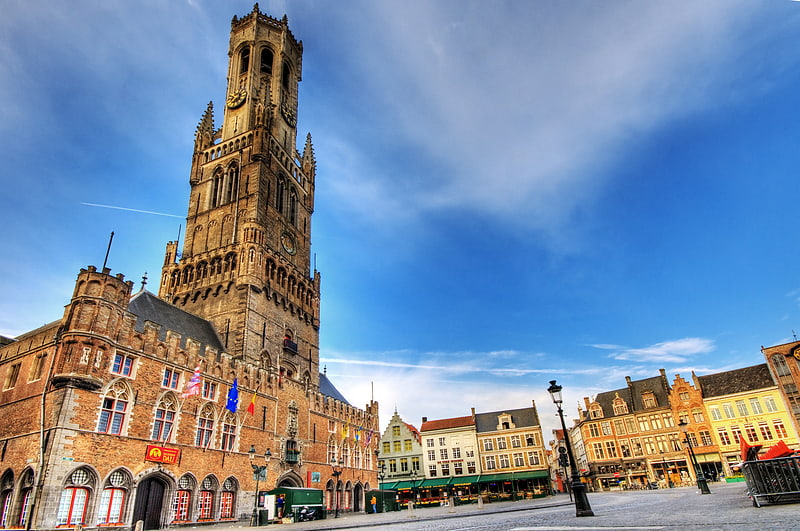
Also known as: Beffroi de Bruges
Medieval bell tower on market square. The Belfry of Bruges is a medieval bell tower in the centre of Bruges, Belgium. One of the city's most prominent symbols, the belfry formerly housed a treasury and the municipal archives, and served as an observation post for spotting fires and other dangers.[1]
Address: Markt 7, 8000 Brugge (Centrum)
Basilica of the Holy Blood

Also known as: Basilique du Saint-Sang de Bruges
Church and pilgrimage site with holy relic. The Basilica of the Holy Blood is a Roman Catholic basilica in Bruges, Belgium. The church houses a relic of the Holy Blood allegedly collected by Joseph of Arimathea and brought from the Holy Land by Thierry of Alsace, Count of Flanders. Built between 1134 and 1157 as the chapel of the Count of Flanders, it was promoted to a minor basilica in 1923.
The basilica in Burg square consists of a lower and upper chapel. The lower chapel, dedicated to St. Basil the Great, is a dark Romanesque structure that remains virtually unchanged. The venerated Passion relic is in the upper chapel, which was rebuilt in the Gothic style in the 16th century and renovated in the 19th century in Gothic Revival style.[2]
Address: Burg 13, 8000 Brugge (Centrum)
Boudewijn Seapark

Old-world theme park with dolphin shows. Boudewijn Seapark is a marine mammal park and theme park located in Sint-Michiels, Bruges, Belgium.[3]
Address: Alfons de Baeckestraat 12, 8200 Brugge (Sint-Michiels)
Church of Our Lady
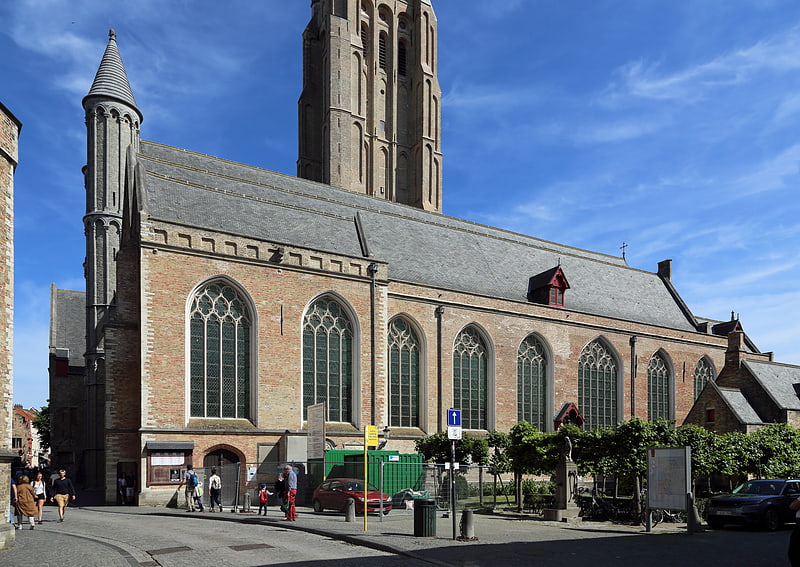
Also known as: Église Notre-Dame
Spire-topped church and Michelangelo art. The Church of Our Lady in Bruges, Belgium, dates mainly from the 13th, 14th and 15th centuries. This church is essentially "...a monument to the wealth, sophistication, taste, and devotion of this most Catholic city, whose history and faith stand today celebrated in this wonderful building."
Its tower, at 115.6 metres (379 ft) in height, remains the tallest structure in the city and the third tallest brickwork tower in the world (after St. Mary's Church in Lübeck and St. Martin's Church in Landshut, both in Germany).
The church demonstrates the Gothic style in the prominent Flying buttresses on the exterior which were constructed in the 1270s and 80s. The nave contains cross-vaults and black and white tiled flooring. The interior demonstrates the heavily ornamented Baroque style in the side aisles and chancel. One of the chapels in the church was created in 1482 for a wealthy man named Lodewijk van Gruuthuse, as his personal worship area.[4]
Address: Mariastraat, Brugge, Bruges (Centrum)
Groeningemuseum
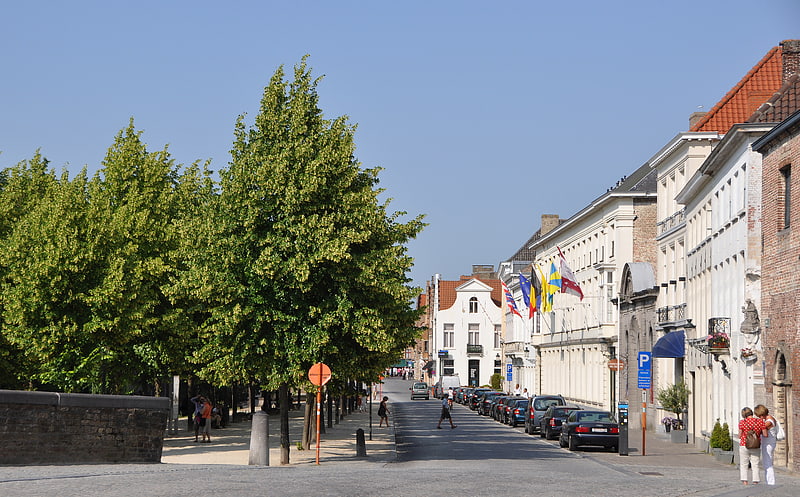
Also known as: Musée Groeninge
Museum of classical Flemish art. The Groeningemuseum is a municipal museum in Bruges, Belgium, built on the site of the medieval Eekhout Abbey.
It houses a comprehensive survey of six centuries of Flemish and Belgian painting, from Jan van Eyck to Marcel Broodthaers. The museum's many highlights include its collection of Early Netherlandish paintings, works by a wide range of Renaissance and Baroque masters, as well as a selection of paintings from the 18th and 19th century neo-classical and realist periods, milestones of Belgian symbolism and modernism, masterpieces of Flemish Expressionism and many items from the city's collection of post-war modern art.[5]
Address: Dijver 12, 8000 Brugge (Centrum)
St. Salvator's Cathedral
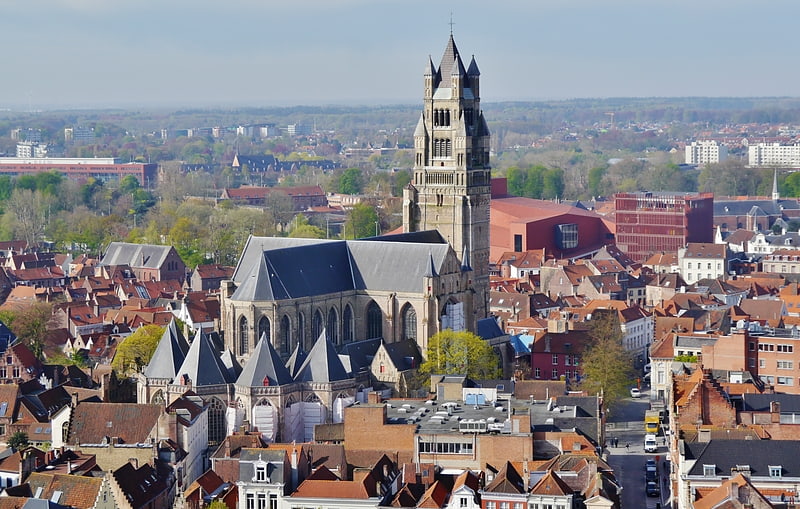
Also known as: Cathédrale Saint-Sauveur de Bruges
Art-filled religious edifice with tower. The Saint-Salvator Cathedral is the cathedral of Bruges, Flanders, in present-day Belgium. The cathedral is dedicated to the Verrezen Zaligmaker and Saint-Donatius of Reims.[6]
Address: Sint-Salvatorskoorstraat 8, 8000 Brugge (Centrum)
Gruuthusemuseum

Also known as: Musée Gruuthuse
Museum in Bruges, Belgium. The Gruuthusemuseum is a museum of applied arts in Bruges, located in the medieval Gruuthuse, the house of Louis de Gruuthuse. The collection ranges from the 15th to the 19th century.[7]
Address: Dijver 17, 8000 Brugge (Centrum)
Jan Breydel Stadium
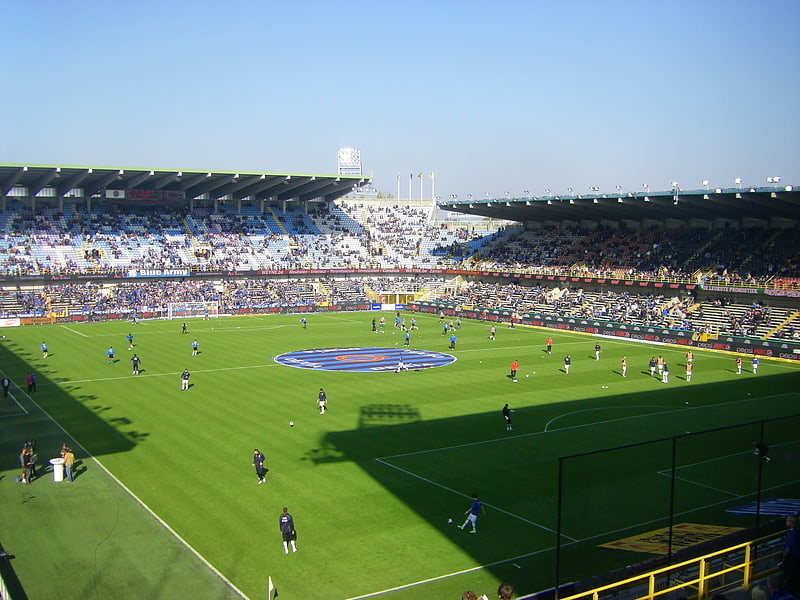
Also known as: Stade Jan-Breydel
Multi-purpose stadium in Bruges, Belgium. Jan Breydel Stadium is a multi-purpose stadium in Sint-Andries, Bruges, Belgium. The city-owned stadium is the home stadium of two top-flight association football clubs, Club Brugge and Cercle Brugge. It is used mainly for football matches, which cost between €5 and €60/seat/match. The stadium was built in 1975. It currently has 29,042 seats. It is named after Jan Breydel, an instigator of the Bruges Matins, the insurgency that led to the Battle of the Golden Spurs. Prior to 1999 and the Euro 2000 Championship the stadium was known as Olympiastadion, the Olympic stadium in Dutch, and had 18,000 seats. During December 2015 the pitch was resurfaced with an Italian proprietary hybrid grass called Mixto.[8]
Address: Olympialaan 74, 8200 Sint-Andries (Sint-Andries)
Markt

Also known as: Grand-Place de Bruges
Popular central plaza with dining. The Markt of Bruges is located in the heart of the city and covers an area of about 1 hectare. Some historical highlights around the square include the 12th-century belfry and the West Flanders Provincial Court (originally the Waterhall, which in 1787 was demolished and replaced by a classicist building that from 1850 served as provincial court and after a fire in 1878 was rebuilt in a neo-Gothic style in 1887. In the center of the market stands the statue of Jan Breydel and Pieter de Coninck.
In 1995 the market was completely renovated. Parking in the square was removed and the area became mostly traffic-free, thus being more celebration friendly. The renovated market was reopened in 1996 with a concert by Helmut Lotti.[9]
Address: Grote Markt, Bruges (Centrum)
Marieke

Marieke is a 1988 statue in Bruges, designed by Jef Claerhout. It is a homage to Jacques Brel's famous song "Marieke".[10]
St. Walburga Church
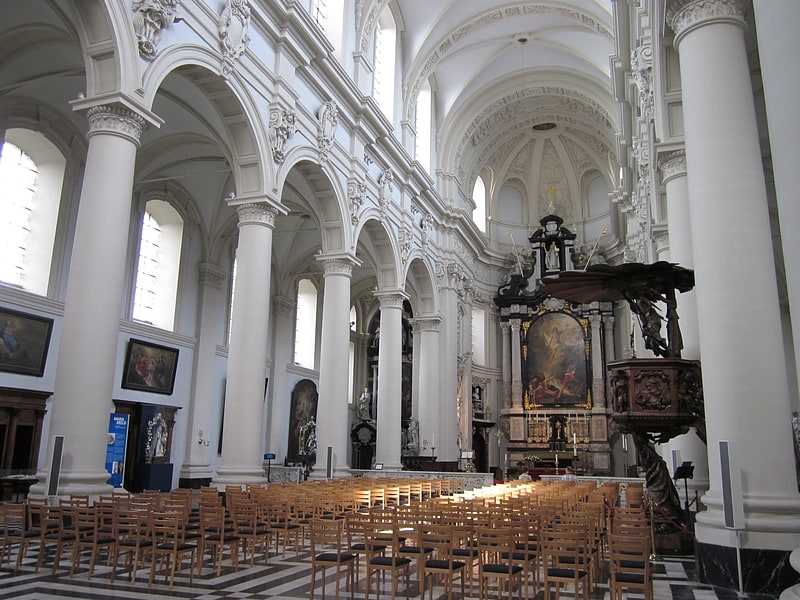
Also known as: Église Sainte-Walburge de Bruges
Church in Bruges, Belgium. The St. Walburga Church is a 17th-century Roman-Catholic church in Bruges built by the Jesuits in a Baroque style. It is now a parish church and contains many valuable art objects.[11]
Address: 1 Sint-Maartensplein, 8000, Brugge, Bruges (Centrum)
Frietmuseum
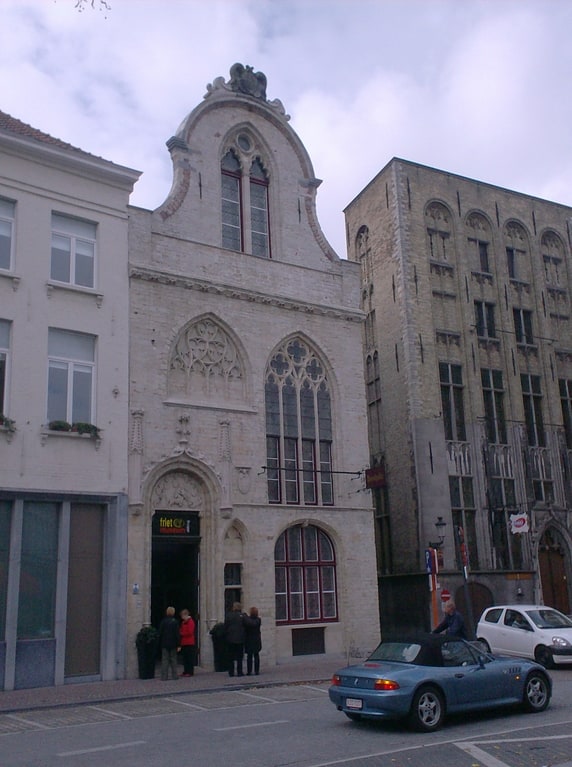
Also known as: Musée de la frite
Museum with the history of Belgian fries. The Frietmuseum is a museum in Bruges, Belgium, which is devoted to the history of potatoes and the production of Belgian fries. It describes itself as "the first and only museum dedicated to potato fries".[12]
Address: Vlamingstraat 33, 8000 Brugge (Centrum)
Choco-Story
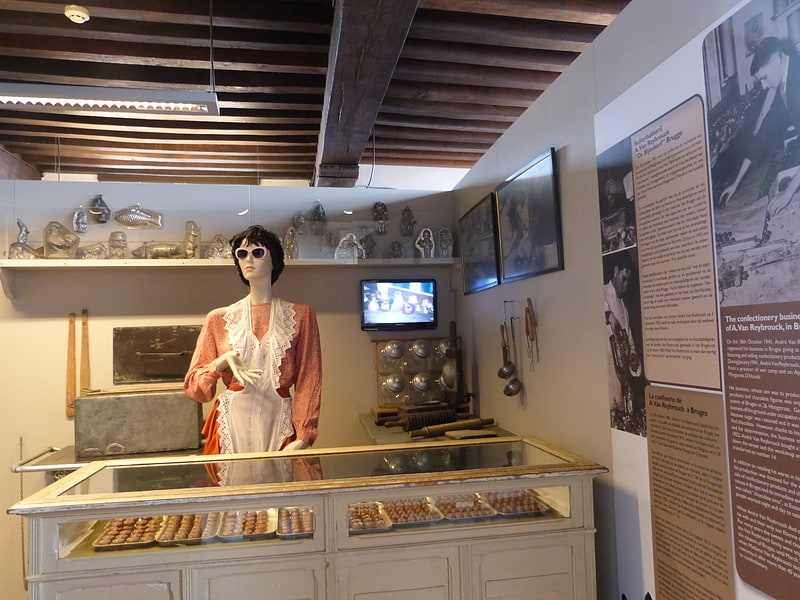
Museum in Bruges, Belgium. Choco-Story, the Chocolate Museum in Bruges, Belgium, is located in the sixteenth-century "Huis de Crone" building on Sint-Jansplein in central Bruges. This building was originally the home of a wine tavern. It later housed a bakery and, most recently, a furniture making shop.
Choco-Story was opened by Eddie Van Belle and his son, Cedric. The two are also the owners of Belcolade, a family-owned chocolate business.
Museum visitors can watch chocolate being made.
Аdditionally, a section of the museum is dedicated to the health benefits of chocolate.[13]
Address: Sint-Jansplein 2, 8000 Brugge (Centrum)
Bruges City Hall
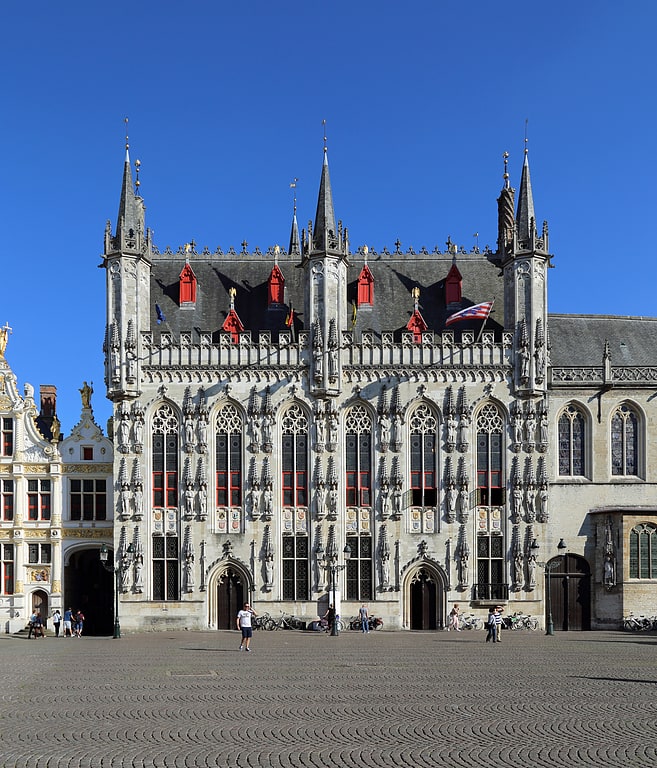
Also known as: Hôtel de ville de Bruges
City or town hall in Bruges, Belgium. The City Hall of Bruges, Belgium, is one of the oldest city halls in the entire Netherlands region. It is located on Burg Square, the area of the former fortified castle in the centre of Bruges.
After a fire in the city's Belfry in 1280 the old Ghyselhuus, which had already fallen into disuse as the jail of the count of Flanders, became the meeting place for the city council. In 1376 the Ghyselhuus was pulled down and replaced by a new purpose built council building. Count Louis laid the foundation stone. Responsibility for its construction was given Jan Roegiers, and the project was completed, eventually, in 1421. The City Hall is the earliest late Gothic monumental-style municipal council building in Flanders or Brabant: its flamboyant opulence testifies to the city's economic and political power at a time when the population of Bruges is believed to have reached more than 37,000, or even 45,000 people.
The pioneering stone facade of the oldest part, which during the sixteenth and seventeenth centuries was several times extended towards the south, inspired in quick succession the city halls of Brussels, Ghent, Leuven and Oudenaarde. The building's admirers highlight the effect of the "Brugian span", referring to the abundance of repeating systematically positioned niches encompassing the windows, though it is not clear that this effect was invented in Bruges.
The statues under the stone baldachin-canopies on the building's facade have been renewed several times. At the time of the French Revolution all the statues were destroyed. A small number of genuine pieces are now included in the collections of the city museum. The crenellated facade is topped off with little turrets and the roof is decorated with its own little crests and dormers. In 1766 the door on the left side of the building's facade was repositioned to make the overall effect more symmetrical.
Between 1895 and 1905 the distinguished local architect, Louis Delacenserie and the Gothic Revival champion Jean-Baptiste Bethune started the restoration of the interior. The lesser and greater council chamber were replaced by a single "Gothic Hall". The rich decoration of this chamber now offered competition to the elaborate exterior facade. The impressive double-vaulted timber ceiling was restored and extended to cover the entire area, while the vaulting over the two eastern bays dates only from the nineteenth century. Medallions in the bosses show New Testament scenes, prophets, evangelists and saints. Decoration of the corbels supporting the roof reflect natural and seasonal themes. On the walls mural paintings by Albrecht De Vriendt show scenes from the history of Bruges. Like the monumental mantle-pieces these are nineteenth-century neo-gothic enhancements. The stone vault from 1766 which had covered the lower level was at the same time replaced by a quasi-historical timber structure, supported by four columns that divide the room into two halves.[14]
Address: Burg 12, 8000 Brugge (Centrum)
Concertgebouw
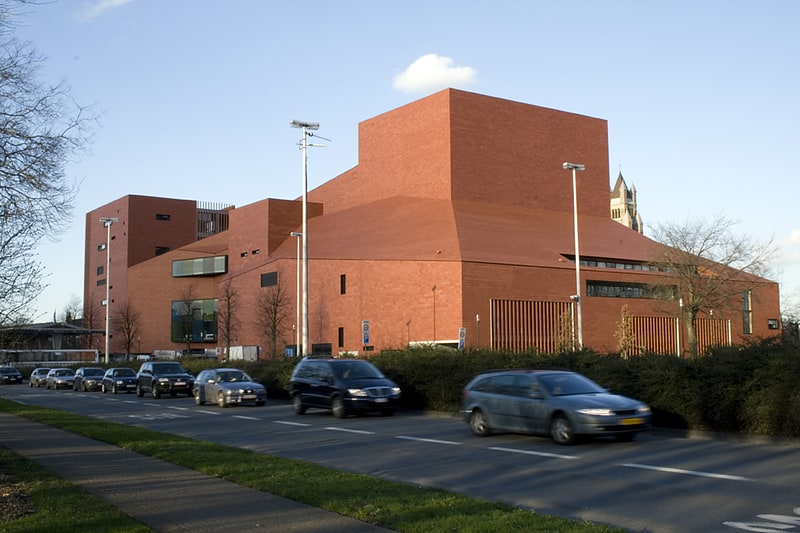
Cultural centre in Bruges, Belgium. The Concertgebouw is a cultural centre in Bruges, Belgium. Located at 't Zand, it was completed in 2002 when Bruges was European Capital of Culture, designed by Paul Robbrecht and Hilde Daem.
The building complex houses a large concert hall seating more than 1290 visitors on three levels and a chamber music hall seating 320. It features a café and room for exhibitions in the Lantaarntoren (Lantern Tower) which offers a view of the historic town.
The building rests on 4,669 poles. The interior is rather sober, and the halls offer excellent acoustics, thanks to advanced technology. The facades are covered with thousands of red terracotta tiles from Saint-Omer in northern France, while the Lantaarntoren is built mainly from glass.
Located close to the historic centre, the building has raises divided reactions: some like its contrasting looks, others think it does not match the architecture of the old town.[15]
Address: 't Zand 34, 8000 Brugge (Centrum)
Bruges–Ostend Canal

The Bruges–Ostend Canal is a 24.6 km long canal in Flanders, Belgium. The canal connects the North Sea to the Belgian interior, running between the cities of Ostend and Bruges. In Bruges, it is connected to three other canals: the Canal Ghent–Bruges, Damme Canal, and Boudewijn Canal which leads to the Port of Zeebrugge. Construction started in 1618, it was finished in 1623.
The 1899 European Rowing Championships were held on the canal in Ostende.[16]
Jan van Eyckplein
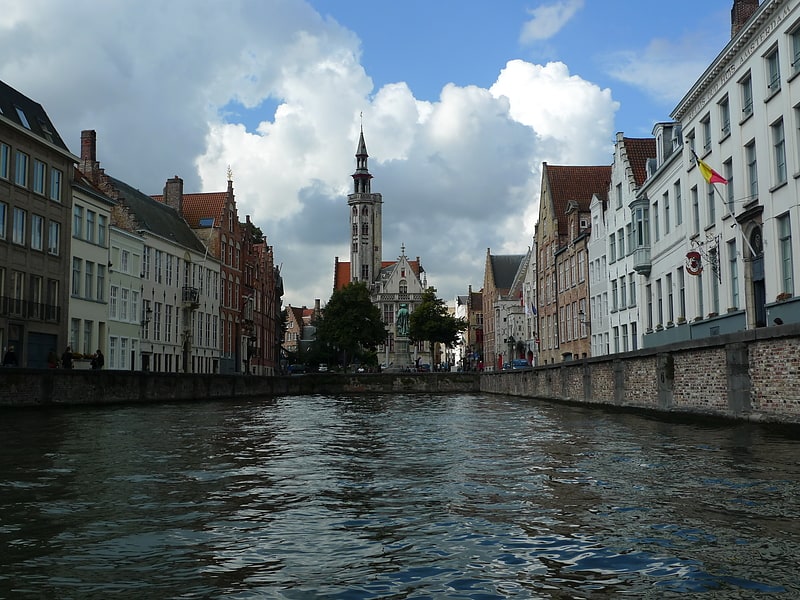
Historical landmark in Bruges, Belgium. Jan van Eyckplein, also known as Jan van Eyck Square, is a square located at the intersection of Academiestraat, Spiegelrei and Spanjaardstraat in Bruges, the capital and largest city of the West Flanders province in the Flemish Region of Belgium. The square is named for noted Northern Renaissance painter Jan van Eyck.[17]
Tillegem Castle

Also known as: Château de Tilleghem
Castle in Bruges, Belgium. Tillegem Castle is a castle in Belgium. Since 1980, the castle and its park have been property of the Province of West Flanders.[18]
Address: 81 Tillegemstraat, Bruges (Sint-Michiels)
Provostry of St. Donatian
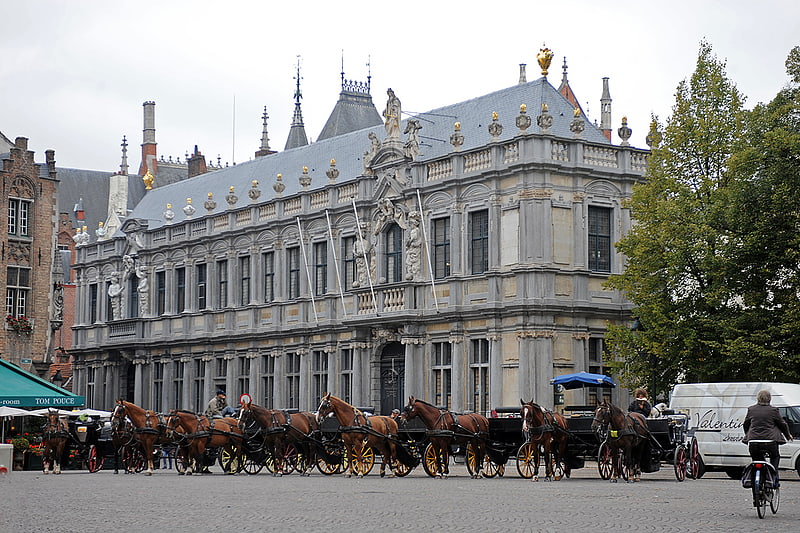
The Provostry of St. Donatian is a Baroque building on the Burg Square in Bruges, Belgium. Built in the 17th century, it served as the headquarters of the ecclesiastical seigniory of St. Donatian.[19]
St. Trudo's Abbey

Castle in Bruges, Belgium. Male Castle, Bruges. A community of the Canonesses Regular of the Holy Sepulchre. It originated in Bruges in the 11th century, and between 1954 and 2013 was settled in Male Castle in Male, Sint-Kruis, Bruges, West Flanders, Belgium.[20]
Address: Pelderijnstraat 14, 8310 Sint-Kruis (Sint-Kruis)
Diamant Museum
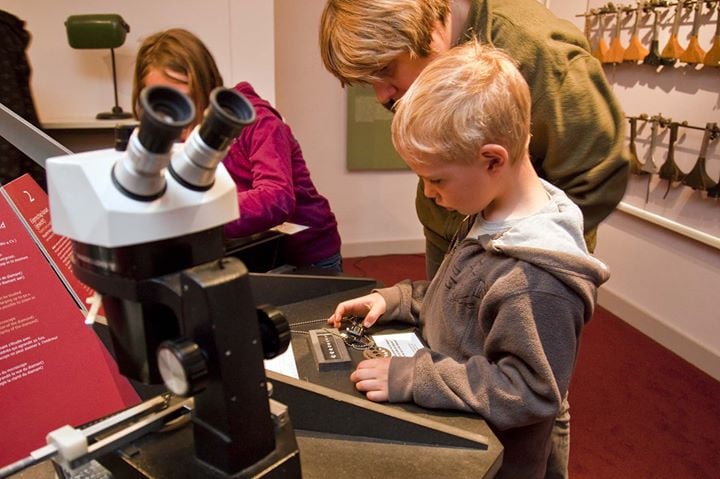
Museum
Address: Katelijnestraat 43, 8000 Brugge (Centrum)
St. James's Church
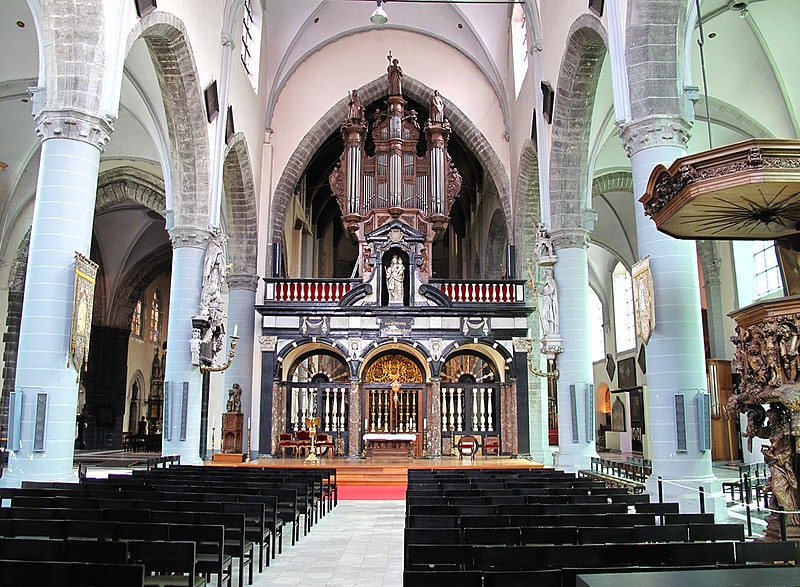
Also known as: Église Saint-Jacques de Bruges
Catholic church in Bruges, Belgium. St. James's Church is a Catholic church in Bruges, Belgium. Originally built around 1240, the church was considerably expanded in 1459 to match the rising affluence of Bruges, and was patronized by the Duke of Burgundy. In the late 17th and early 18th centuries the church's interior was remodeled in its present Baroque style.
The church is sometimes wrongly called St. Jacob's. The confusion arises because Flemish, like many other languages, uses the same word for both James and Jacob.[21]
Oud Sint Jan

Also known as: Ancien hôpital Saint-Jean
Museum in an 11th-century hospital. The Hospital of St. John was a medieval hospital in Bruges. It was founded in the mid-12th century.
Located next to the Church of Our Lady, the premises contain some of Europe's oldest surviving hospital buildings. The hospital grew during the Middle Ages and was a place where sick pilgrims and travellers were cared for. The site was later expanded with the building of a monastery and convent. In the 19th century, further construction led to a hospital with eight wards around a central building.
Not until 1977 did the building's function as a hospital stop, at which time it was moved to a newer modern hospital in Brugge Sint-Pieters. The city of Bruges took over the buildings. Today part of the hospital complex holds the popular Hans Memling museum, named for the German-born Early Netherlandish painter, where a number of works, such as triptychs are displayed, as well as hospital records, medical instruments and other works of art.
The hospital site is also used as a congress and exhibition centre, the site Oud Sint-Jan.[22]
Address: Mariastraat 38, Bruges (Centrum)
St. Andrew's Abbey
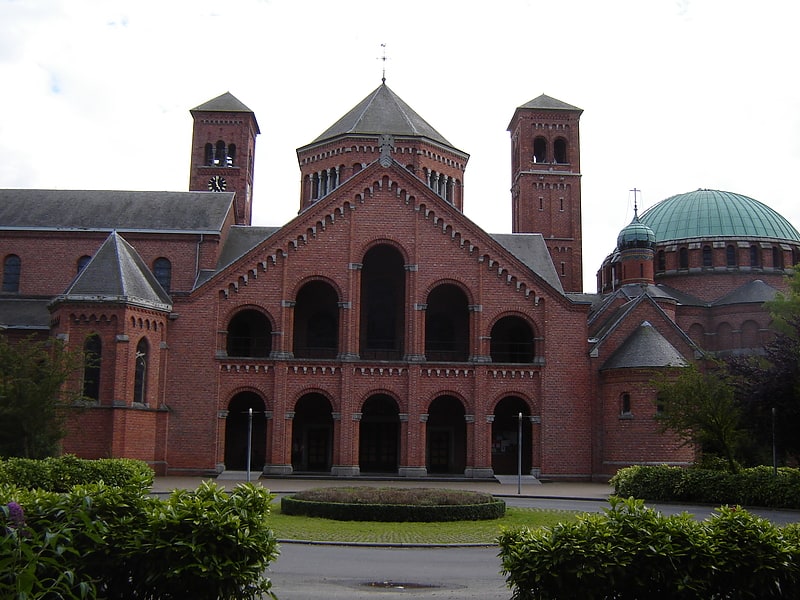
Also known as: Abbaye Saint-André de Bruges
Abbey. St. Andrew's Abbey, Bruges was a Benedictine abbey in Sint-Andries, Bruges, Belgium, which was destroyed in the French Revolution. Its modern successor St. Andrew's Abbey, Zevenkerken, founded in 1899–1900, is a Benedictine abbey of the Congregation of the Annunciation.[23]
Provinciaal Hof

Tourist attraction in Bruges, Belgium. The Provinciaal Hof is a Neogothical building on the market place in Bruges, Belgium. It is the former meeting place for the provincial government of West Flanders.[24]
Address: 3 Markt, Bruges (Centrum)
Kantcentrum

Museum, Specialty museum
Address: Balstraat 16, 8000 Bruges (Centrum)
Ezelpoort
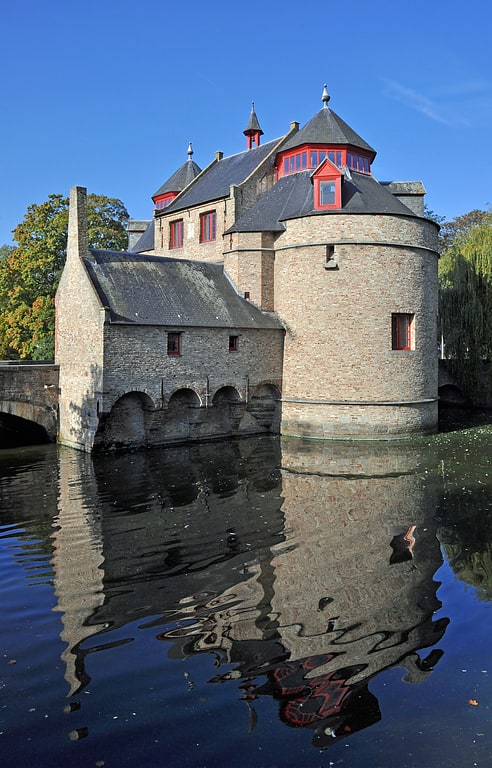
Forts and castles, City gate, Historical place
Address: Ezelstraat 122, 8000 Bruges (Bruges)
Lucifernum
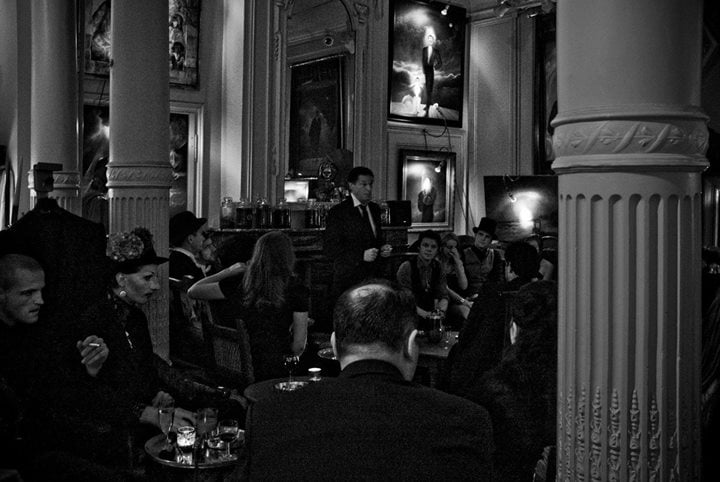
Museum, Bars and clubs, Nightlife
Address: Twijnstraat 6, 8000 Brugge (Centrum)
Stedelijk Museum voor Volkskunde 'De Zwarte Kat'
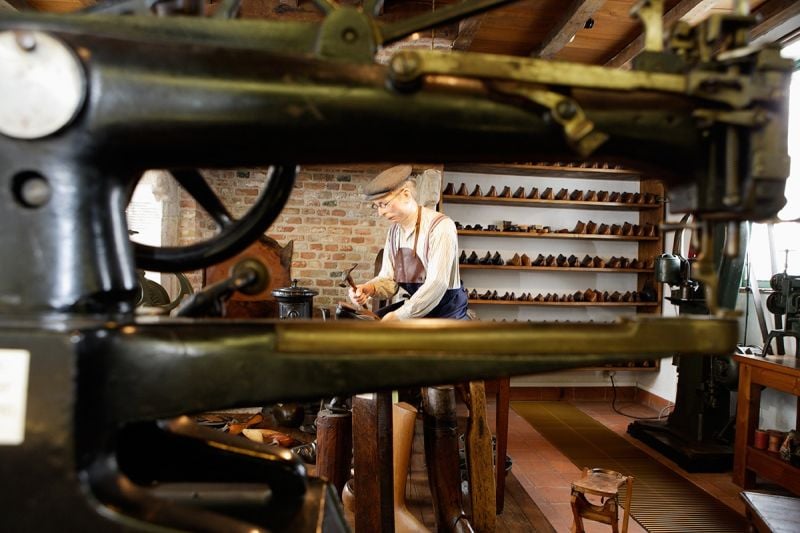
Museum
Address: 43 Balstraat, Bruges (Centrum)
Historium
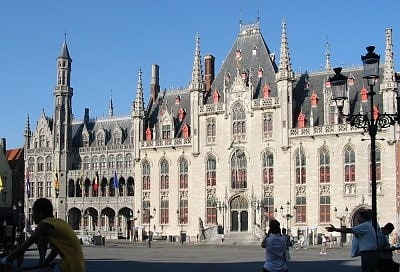
Museum, Specialty museum, History museum, Tourist information
Address: Markt 1, 8000 Brugge (Centrum)
Frank Brangwyn-Arentshuis

Museum, Art museum, History museum
Address: Dijver 16, 8000 Brugge (Centrum)
Gouden Hand
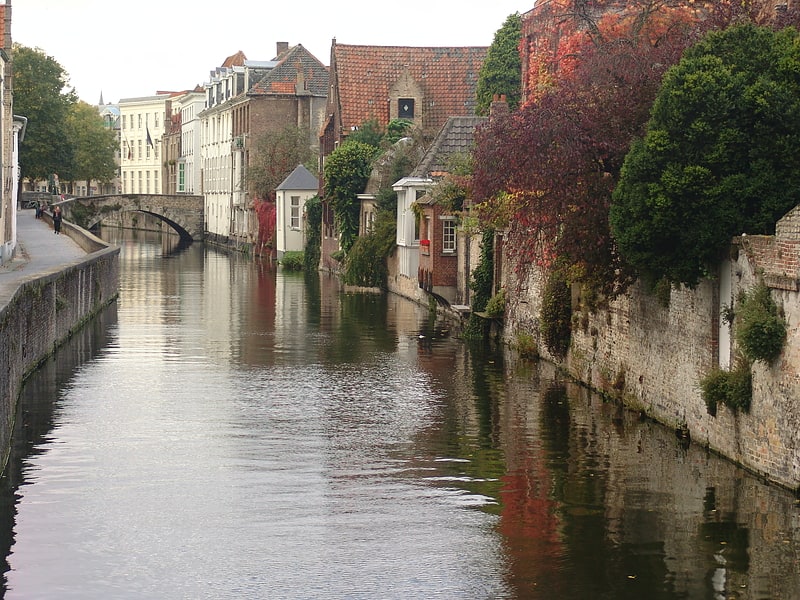
Gouden Hand is a canal in Bruges, Belgium.
Goudenhand is also the name of two streets along the same canal. These are, Goudenhandrei immediately along the canal ("rei" being the name given to Bruges' canals) and Goudenhandstraat along the opposite side in a line parallel but not contiguous to the canal. Whereas Goudenhand Building is the name of a 17th-century building situated along the canal's bank next to one of its bridges.
Goudenhand building is used by the College of Europe for student accommodation since 1985 after its acquisition and renovation by the College.[25]
Ter Doest Abbey
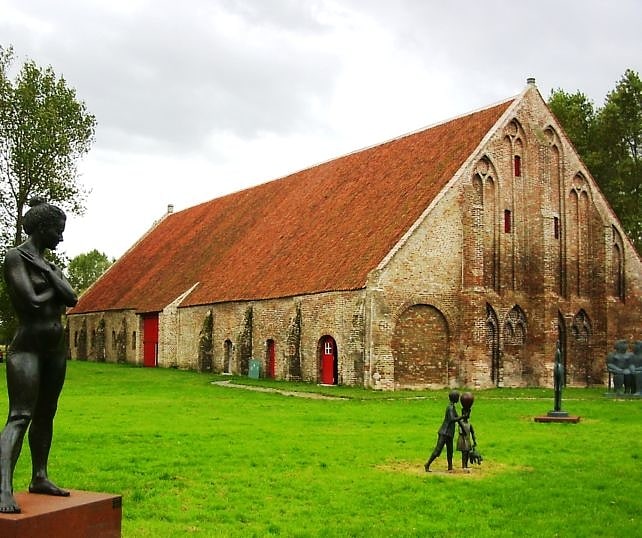
Also known as: Abbaye de Ter Doest
Abbey. Ter Doest Abbey was a Cistercian abbey in Belgium, in the present Lissewege, a district of Bruges, West Flanders.[26]
Kruispoort
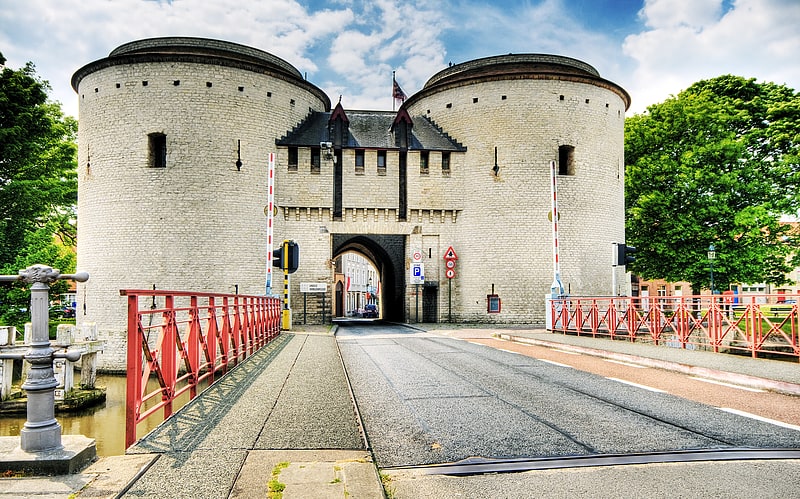
City gate
Port of Zeebrugge
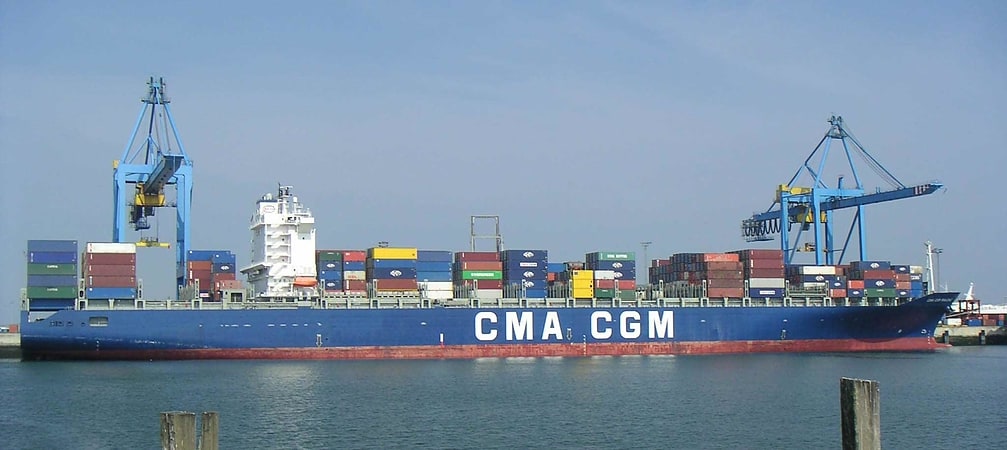
Also known as: Port de Bruges-Zeebruges
Shipping service in Bruges, Belgium. The Port of Zeebrugge is a large container, bulk cargo, new vehicles and passenger ferry terminal port on the North Sea. The port is located in the municipality of Bruges, West Flanders in the Flemish Region of Belgium, handling over 50 million tonnes of cargo annually.
The port of Zeebrugge is managed by the port authority MBZ (Maatschappij van de Brugse Zeehaven - translated: 'Company of the Bruges Seaport'), an autonomous company regulated by public law, the city of Bruges being the main shareholder.[27]